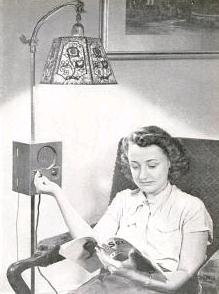 Seventy-five years ago, Popular Science, December 1939, showed how to make this handy radio to be clamped onto any convenient floor lamp (or simply be used as a standard table radio). It had a myriad of potential uses. “Mounted on a bridge lamp it provides a radio for card games; attached to a floor lamp beside your favorite chair it puts the evening’s programs at your finger tips; and fastened to a standing lamp in your bedroom it serves as a convenient bedside set.”
Seventy-five years ago, Popular Science, December 1939, showed how to make this handy radio to be clamped onto any convenient floor lamp (or simply be used as a standard table radio). It had a myriad of potential uses. “Mounted on a bridge lamp it provides a radio for card games; attached to a floor lamp beside your favorite chair it puts the evening’s programs at your finger tips; and fastened to a standing lamp in your bedroom it serves as a convenient bedside set.”
Frankly, the “floor lamp” feature sounds a bit like an afterthought. The cabinet is hinged and includes cutouts to go around the lamp. A decorative band on the lamp, or a hose clamp, keeps the radio from sliding down.
The guts of the radio itself consist of a two-tube circuit consisting of two loctal tubes. A 7A7 serves as the regenerative detector, with the regeneration control used to control the volume. A 32L7 serves as the audio amplifier and rectifier. It’s an AC/DC set, with a 220 ohm resistor used to drop the line voltage to power the filaments. Because it’s run right off the AC line, there is a capacitor between the external antenna and the set, which the diagram reveals would otherwise be connected directly to one side of the line cord. The article contains a stern warning that this condenser “is extremely important, since it eliminates any possibility of blowing out the tubes or burning the primary of the antenna coil (which could start a fire) should the antenna wire or antenna lead accidentally come in contact with a grounded pipe or radiator” or, worse yet, some hapless person who happens to be touching the radiator.
I wonder how many people built such a radio. By this time, nearly every commercial radio sold was a superheterodyne, rather than the sometimes tempramental regenerative circuit used here. But still, a radio such as this one would be a pretty good performer, and quite suitable as a second radio after the big one in the parlor.
According to the 1942 Allied Radio Catalog (the new loctals were not yet shown in the 1939 catalog), the tubes would cost a total of $1.36. The least expensive table radio in the 1939 Allied catalog (a four-tube superhet) was $6.95. Since most of the other parts could probably be scavenged from a broken radio, building this little two-tube set could represent a bargain for someone wanting to boast two radios in their home.
